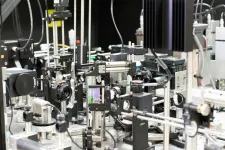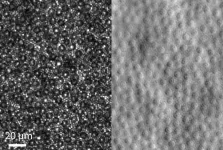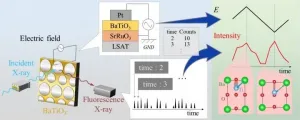Robots learn faster with quantum technology
2021-03-11
(Press-News.org) Robots solving computer games, recognizing human voices, or helping in finding optimal medical treatments: those are only a few astonishing examples of what the field of artificial intelligence has produced in the past years. The ongoing race for better machines has led to the question of how and with what means improvements can be achieved. In parallel, huge recent progress in quantum technologies have confirmed the power of quantum physics, not only for its often peculiar and puzzling theories, but also for real-life applications. Hence, the idea of merging the two fields: on one hand, artificial intelligence with its autonomous machines; on the other hand, quantum physics with its powerful algorithms.
Over the past few years, many scientists have started to investigate how to bridge these two worlds, and to study in what ways quantum mechanics can prove beneficial for learning robots, or vice versa. Several fascinating results have shown, for example, robots deciding faster on their next move, or the design of new quantum experiments using specific learning techniques. Yet, robots were still incapable of learning faster, a key feature in the development of increasingly complex autonomous machines.
Within an international collaboration led by Philip Walther, a team of experimental physicists from the University of Vienna, together with theoreticians from the University of Innsbruck, the Austrian Academy of Sciences, the Leiden University, and the German Aerospace Center, have been successful in experimentally proving for the first time a speed-up in the actual robot's learning time. The team has made use of single photons, the fundamental particles of light, coupled into an integrated photonic quantum processor, which was designed at the Massachusetts Institute of Technology. This processor was used as a robot and for implementing the learning tasks. Here, the robot would learn to route the single photons to a predefined direction. "The experiment could show that the learning time is significantly reduced compared to the case where no quantum physics is used", says Valeria Saggio, first author of the publication.
In a nutshell, the experiment can be understood by imagining a robot standing at a crossroad, provided with the task of learning to always take the left turn. The robot learns by obtaining a reward when doing the correct move. Now, if the robot is placed in our usual classical world, then it will try either a left or right turn, and will be rewarded only if the left turn is chosen. In contrast, when the robot exploits quantum technology, the bizarre aspects of quantum physics come into play. The robot can now make use of one of its most famous and peculiar features, the so called superposition principle. This can be intuitively understood by imagining the robot taking the two turns, left and right, at the same time. "This key feature enables the implementation of a quantum search algorithm that reduces the number of trials for learning the correct path. As a consequence, an agent that can explore its environment in superposition will learn significantly faster than its classical counterpart," says Hans Briegel, who developed the theoretical ideas on quantum learning agents with his group at the University of Innsbruck.
This experimental demonstration that machine learning can be enhanced by using quantum computing shows promising advantages when combining these two technologies. "We are just at the beginning of understanding the possibilities of quantum artificial intelligence" says Philip Walther, "and thus every new experimental result contributes to the development of this field, which is currently seen as one of the most fertile areas for quantum computing".
INFORMATION:
Publication in "Nature":
"Experimental quantum speed-up in reinforcement learning agents", V. Saggio, B. Asenbeck, A. Hamann, T. Strömberg, P. Schiansky, V. Dunjko, N. Friis, N. C. Harris, M. Hochberg, D. Englund, S. Wölk, H. J. Briegel, and P. Walther, Nature, March 2021; DOI: 10.1038/s41586-021-03242-7
ELSE PRESS RELEASES FROM THIS DATE:
2021-03-11
Scientists have discovered a route of introduction for High Pathogenicity Avian Influenza Virus (HPAIV) H5N8 into Japan and, in parallel, have investigated the potential of two human anti-influenza drugs for the control of HPAI in birds.
Since October 30, 2020, there have been over 30 recorded outbreaks of High Pathogenicity Avian Influenza (HPAI) in domestic poultry and wild fowl in Japan. This outbreak was caused by the influenza A virus H5N8, a known High Pathogenicity Avian Influenza Virus (HPAIV). In such a scenario, identification of the source of the virus and its transmission route is important to control its spread.
A team of scientists led by Professor Yoshihiro Sakoda of Hokkaido University have recently found the probable route of introduction of ...
2021-03-11
WASHINGTON -- Researchers have developed a noninvasive technique that can capture images of rod and cone photoreceptors with unprecedented detail. The advance could lead to new treatments and earlier detection for retinal diseases such as macular degeneration, a leading cause of vision loss.
"We are hopeful that this technique will better reveal subtle changes in the size, shape and distribution of rod and cone photoreceptors in diseases that affect the retina," said research team leader Johnny Tam from the National Eye Institute. "Figuring out what happens to these cells before they are lost is an important step toward developing earlier interventions to treat and prevent blindness."
In Optica, The Optical Society's (OSA) journal for high impact research, the researchers show that ...
2021-03-11
A team led by scientists at the National Eye Institute (NEI) has noninvasively visualized the light-sensing cells in the back of the eye, known as photoreceptors, in greater detail than ever before. Published in Optica, the researchers report how they improved imaging resolution by a third by selectively blocking the light used to image the eye. NEI is part of the National Institutes of Health.
The achievement is the latest in an evolving strategy to monitor cell changes in retinal tissue that, in turn, will help identify new ways to treat and prevent vision loss from diseases such as age-related macular degeneration, a leading cause of blindness in people age ...
2021-03-11
DALLAS, March 11, 2021 -- Non-O blood type may increase the risk of stroke among women who smoke and take oral contraceptives, according to preliminary research to be presented at the American Stroke Association's International Stroke Conference 2021. The virtual meeting is March 17-19, 2021 and is a world premier meeting for researchers and clinicians dedicated to the science of stroke and brain health.
According to the most recent comprehensive data (January 2020) from the Centers for Disease Control and Prevention (CDC), stroke is the fifth leading cause of death in the United States and a major contributor to long-term disability. Some risk factors ...
2021-03-11
Rainbows are some of the most spectacular optical phenomena in the natural world and Hawai'i has an amazing abundance of them. In a new publication, an atmospheric scientist at the University of Hawai'i at Mānoa makes an impassioned case for Hawaii being the best place on Earth to experience the wonder of rainbows. He begins by highlighting the Hawaiian cultural significance of rainbows, he reviews the science of rainbows and the special combination of circumstances that makes Hawai'i a haven for rainbows.
"The cultural importance of rainbows is reflected in the Hawaiian language, which has many words and phrases to describe the variety of manifestations in Hawai'i," said author Steven Businger, professor in the UH ...
2021-03-11
DALLAS, March 11, 2021 -- Stroke patients were nearly 50% more likely than heart attack patients to develop depression, and female stroke patients had a higher risk of depression than their male counterparts, according to two preliminary studies by the same research group to be presented at the American Stroke Association's International Stroke Conference 2021. The virtual meeting is March 17-19, 2021 and is a world premier meeting for researchers and clinicians dedicated to the science of stroke and brain health.
In what researchers described as one of the largest ...
2021-03-11
Researchers in Japan have used a novel, ultra-fast technique to explore the fine structure of a potential alternative material to lead titanate, a ferroelectric material widely used for sensors in many everyday devices. Understanding this structure takes us a step closer to eliminating these remaining sources of lead pollution.
The study appeared in the materials science journal Acta Materialia on 21 January.
Ferroelectric materials are used in a wide range of practical applications, from capacitors to memory cells, medical ultrasound to data storage and displays. These materials have a spontaneous polarization, or direction, of their electrons that can be switched back and forth via the application of an electric field, called ferroelectricity.
Worldwide, society is increasingly ...
2021-03-11
DALLAS, March 11, 2021 -- When NA1, a neuroprotectant, was delivered to the brain in nanoparticles, it reduced stroke severity and improved survival in a mouse model of stroke, according to preliminary research to be presented at the American Stroke Association's International Stroke Conference 2021. The virtual meeting is March 17-19, 2021 and is a world premier meeting for researchers and clinicians dedicated to the science of stroke and brain health.
In an earlier human trial (the ESCAPE-NA1 trial), NA1, a small peptide designed to save brain cells from death after stroke, showed mixed results when NA1 was administered to patients undergoing clot removal for severe ...
2021-03-11
DALLAS, March 11, 2021-- Stroke survivors may be more likely to attempt or die by suicide than people who have not had a stroke, according to preliminary research to be presented at the American Stroke Association's International Stroke Conference 2021. The virtual meeting is March 17-19, 2021 and is a world premier meeting for researchers and clinicians dedicated to the science of stroke and brain health. This study will be simultaneously published in the American Heart Association's journal Stroke.
Rates of depression among stroke survivors range from 28% to 35%, and stroke is considered an independent risk factor for depression. Since depression after a stroke has been associated with increased suicidal ...
2021-03-11
Contains updated information not available in the abstract.
DALLAS, March 11, 2021 -- Having an ischemic stroke increases dementia risk, and that risk escalates with the number and severity of strokes, according to preliminary research to be presented at the American Stroke Association's International Stroke Conference 2021. The virtual meeting is March 17-19, 2021 and is a world premier meeting for researchers and clinicians dedicated to the science of stroke and brain health.
Ischemic stroke is the most common stroke type, accounting for 87% of all strokes. It occurs when a vessel supplying blood to the brain is obstructed. Stroke is the leading preventable cause ...
LAST 30 PRESS RELEASES:
[Press-News.org] Robots learn faster with quantum technology




